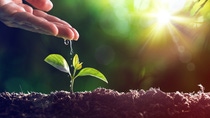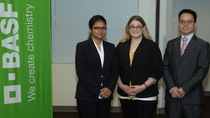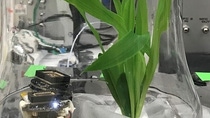Media
Sensor technology translates language of plants
Doctoral students unveil a device during BASF’s annual science competition that could take precision farming to a new level.

Plants have a lot to say, if you know how to listen to them. For this reason, a scientist and two engineers from North Carolina State University have collaborated on a project—learning the language of plants and devising an electronic device sensitive enough to detect pests, pathogens and other stressors before the plants show visible signs of trouble.
It was this device—able to detect biotic plant stress—that won the three-person team a first-place award at the fourth annual BASF North American Science Competition at the company’s Research Triangle Park location in North Carolina.
Plant pathologist Nasie Constantino, Ph.D., and electrical engineers/Ph.D. students Marzana Mantasha Mahmud and Chunkyun Seok each received $1,000 in cash with a chance to showcase their project in a real-life situation.
The NC State group was selected from 13 teams that submitted projects to the competition, and later from three team finalists who presented their technology to a panel of judges in a “Shark Tank” style format. All participants had to answer the following question: What technologies can be used for rapid and quantitative identification of plant responses to biotic stress?
The BASF staff decided on an agricultural question for this year’s competition—to help farmers detect and diagnose plant well-being and plant stress in real time—a technology that doesn’t require lengthy testing and analysis of samples in a lab.
Since plant health is often affected by several environmental abiotic and biotic factors, agricultural companies are especially interested in identifying plant responses to biotic factors, such as pathogens and insects.
“Digitalization in agriculture is increasing dramatically, both from a commercial grower utilization and in facilitating accelerated research in development,” said Luke Bozeman, Director, Research and Development Agricultural Solutions, North America, BASF, and one of the judges of the competition.
And the reason the NC State team took home the first-place prize was two-fold.
“Their solution went across disciplines from electronics to agricultural systems to digital information capture. They really showed that they had collaborated quite well,” Bozeman added. “The second thing was we could see a path to their idea having a commercial impact in the industry.”
One of the opportunities for the winning team is a NARET-funded proof of concept research project, said Christopher Hewitt, Science Relations Manager, BASF, and organizer of the competition.
“The team’s technology is still a long way from market, but it is exciting and shows real promise,” Hewitt added.


Constantino said she had no idea her team would win when entering the competition. She just hoped to share her team’s research with the rest of the world.
“Different types of stresses are going to make a plant produce volatiles, and they are going to be different with each stress. We want to take advantage of these specific sets of volatiles, try and think of them as fingerprints—so each different stress creates a unique fingerprint,” she explained. “What we want to do is have a sensor that can actually determine what types of volatiles are being produced and then tell what the stress is.”
To sense these elements, Constantino’s team designed a sensor technology based on capacitive micromachined ultrasonic transducers (CMUT). This sensor shows sensitivity to detecting volatile organic compounds produced by systemically wounded maize plants that her team believed can be tuned to provide real-time detection of stress related VOCs in field situations, according to the proposal the team submitted to the competition.
Constantino said the sensor could also be used in third-world countries, to detect pathogens early on and stop them from spreading. The sensor has six to eight channels and different polymers could be put on each channel, allowing the polymers to detect various volatiles.
“Once we wound the stem, the sensors go off immediately,” she added.
What makes Constantino’s story even more fascinating is that she’s been an insulin-dependent diabetic since age 6 who needs to watch her blood sugar levels. As a result, she has a live-in watchdog who’s already saved her life several times by alerting her to low blood sugar levels thanks to his keen sense of smell. So, it was this German Shepherd’s companionship that helped her understand volatile production and distress signals, mirroring life imitating art, or in this case—work imitating her life.
“Plants use volatiles to communicate, and I made the connection that I’m communicating with my service dog through volatiles,” she said. “I am sending a distress signal just like my plants are.”
For this reason, Constantino and her team have bigger plans for the sensor technology that will expand beyond plant volatiles detection, and into an array of different fields, from agriculture and sensing of E-coli or Salmonella infections in lettuce, to future medicine for diabetics.
“I do love my service dog and I appreciate him, but I think that the better option in the future is to actually have these sensors attach to diabetics so that the sensor can go off when the blood sugar is low or high,” she concluded.
Published by Anna Spiewak.
For media inquiries or to repurpose this article, contact Lisa Brown.